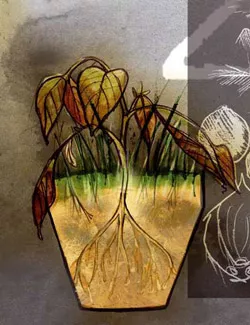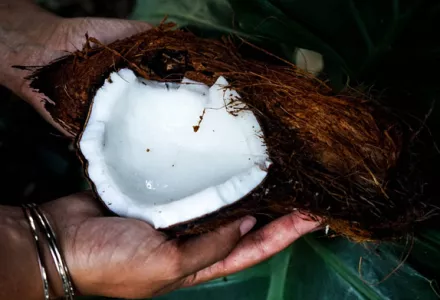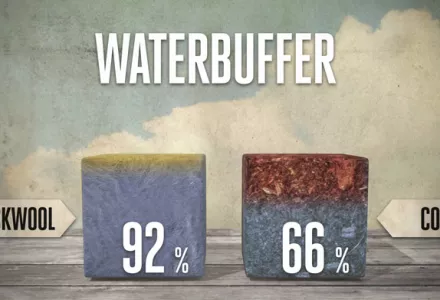There are very many different types of coco medium available on the market today, from many different manufacturers, and that number is constantly growing. of course, all of them claim quality, but what constitutes a ‘quality’ coco medium product?
For any mediums used in container or bed gardening, the primary concern is consistency, from batch to batch, and from year to year. The medium must be free from weed seeds and pathogens that may stop the grower from achieving the best possible results. It also should have a stable physical structure and chemical composition. There is no difference between coco and any other medium in this regard, but achieving quality coco is a whole different issue.
Every medium has its own characteristics and qualities, and these need to be borne in mind when using them. Peat, for example, has a naturally low pH which inhibits most pathogen activity; but this changes when it is limed. Once the pH is raised, any micro-organisms in the peat, such as fungal spores, are primed for growth. Mineral soils – such as sand, clay or humus – usually contain pathogens and weed seeds. This means that they must be sterilized before use, either chemically (never the best option) or thermally (the easier and better option).
Other items such as coco or rice hulls (the by-products of other industries) must be broken down first to make them suitable for use as a growing medium (in order for them to fulfil the requirements of any medium: water retention, adaptable environment in the root zone, and plant support). So bearing in mind all these different requirements, how do we make a quality coco medium? The answer is from the moment the nut drops from the tree.
Benchmarks
The benchmarks for quality coco medium are:
- physical structure
- chemical stability
- free of weed seeds and pathogens
- consistency
Coco for the market is basically a mixture of three main components, which are differentiated according to their size – namely, chips, fibres, and grit (also dust or coco peat). The size of each particle, and its functions, will determine the aggregate structure of the medium. By ‘structure’, we not only mean the size of the particles, but also the amount and size of the pores that result in the mixture.
There is an ideal structure that will produce the best conditions for any given plant. Where there are many small aggregates (pieces or particles), this leads to lots of small pores, so the soil will hold a lot of water but retain less air. Conversely, if the pores are large, there will be a lot of air, but less water. Coco grit is actually made up of many little ‘sponges’ that hold a lot of water but no air. Using different size fractions of grit enables large pore spaces between grit particles. Adding fibres can also have an impact in the same way.

All organic materials will decompose, and of course this includes coco husks. The husks, which are the source of coco medium, are soaked in water for a long time and then the big and thicker fibres are removed. The smaller or broken fibres are left over, along with lots of grit or dust. This mixture is then left to decompose for a certain amount of time until it becomes usable.
Coconut plants are able to use extremely salty water. To do this, the salt level inside the plant has to be greater than the salt level of the salty water, so that the water will be taken up by the plant cells through osmosis. However, high salt levels inside cells would kill the cell, so the plant concentrates the salts in the spaces between cells. As the coco plant matter decomposes, these salts are released. The amount of salts released is greatest when the material is freshest and slows with decomposition; however, decomposition should not be allowed to proceed too far because as the particles get smaller, they may become too small to be of use.
So the coco material must be aged to the right point, then washed with fresh water to remove the very high salt levels. Potassium is one of the salts that is released in the greatest quantity, so this needs to be adjusted using a component that will also rebalance the ratio of potassium to other elements, such as calcium, so that those other elements will be plant-available too.
Buffering
In order to permanently stabilize both the chemistry of the medium and its pH, an adjusting component (known as buffering) must be added prior to use. If the coco is to be mixed with peat or soil, this can be done when the initial fertilizer charge is mixed with the medium prior to planting, in order to fix the ratio of nutrients.
If the coco is used in its pure form, this is best done before planting in the pure coco. The nutrients used for crop production are supplied in a unique formulation or ratio, which is designed for the chemistry of that coco. This will ensure that the coco medium provides the optimum amount of nutrients. The grower must also remember to allow for some leaching (minimum 20%) when watering and only to water the crops with the nutrient formulation (‘constant feed’). This will provide the right conditions for growth, as long as the weeds do not take over.
A weed is any plant that grows where people do not want it to grow. Weeds introduce variables into the growing equations that are not welcome. Weeds consume nutrients, act as hosts for pathogens and insects and rob the crop of light and water. Clean coco medium (or indeed any other medium) should never be a source of different plant species, nor should it be a source of pathogens.
However, when coco is thrown into giant piles, left to rot for a time and then packaged for use, this is a real opportunity for weeds and pathogens. Fungal spores are not affected by the use of gas and heat alone is not economically feasible, so there are only two ways to clean coco for use in growing:

- Sterilize the material by steaming it before packaging
- Ensure that the decomposing coco is not exposed to these issues and remains free of pathogens to start with
Steam sterilizing is much cheaper but, for coco, is not the optimum method.
Steam sterilizing
Several things occur in coco when steam is used to sterilize the medium. The structure of the coco changes, the fibres become shorter and as a result it retains much more water, which is not a good thing. The coco particles also become smaller and softer leading to a decrease in larger pore space even with the addition of a separate component such as perlite. We can picture this like dried noodles: when they are dry, they retain their shape and there is space between them. After ‘steaming’ or cooking, they stick to each other even when you put a fork between them. There is almost no space left for air.
But the particles are not the only thing to be damaged by this ‘cooking process’. Any existing plant-available nitrates (NO3-) are converted into plant toxic nitrites (NO2-). Nitrites can also be taken up by the plant and consumed, but they are known carcinogens and can cause a condition in animals which changes the chemistry of the blood, rendering it unable to carry oxygen. Steaming also impacts on the availability of many micro-nutrients, particularly manganese, which sometimes becomes available to the plant at toxic levels. Steam sterilizing, dry heating, fumigation, or chemical drenches (which also leave behind a chemical residue) all have one very negative effect on coco: they totally clean the medium.

Cleaning the medium disrupts the natural ecological balance of the decomposing medium. Healthy medium has the correct concentrations of micro-life to continue breaking down organic matter in the right way while not affecting the nutrients applied for the plant. If all micro-life has been killed, on the other hand, general decomposers take over, stripping the medium of all its nutrients and out-competing the plants for the available nutrients.
Maintaining a balance is critical to the health of the medium and the crop. Simply dumping a heterogeneous mixture of ‘beneficial’ organisms into the medium does not work. One organism begins to break down fresh organic matter a little and then excretes the substrate for the next organism, a process which continues until the organic component changes completely.
Unless a second-step food source is available from the activity of the first organism, the second-step organism will starve and die. General decomposers use up most of the nutrient pool in the medium.
Of course, the plants also derive their sustenance from these pools but they are much slower to take up nutrients. The decomposers use up the nutrients before the plants get a chance. The best approach is therefore to control the crop from the beginning and prevent these types of problems before they happen. Sterilized coco medium is best avoided.
















